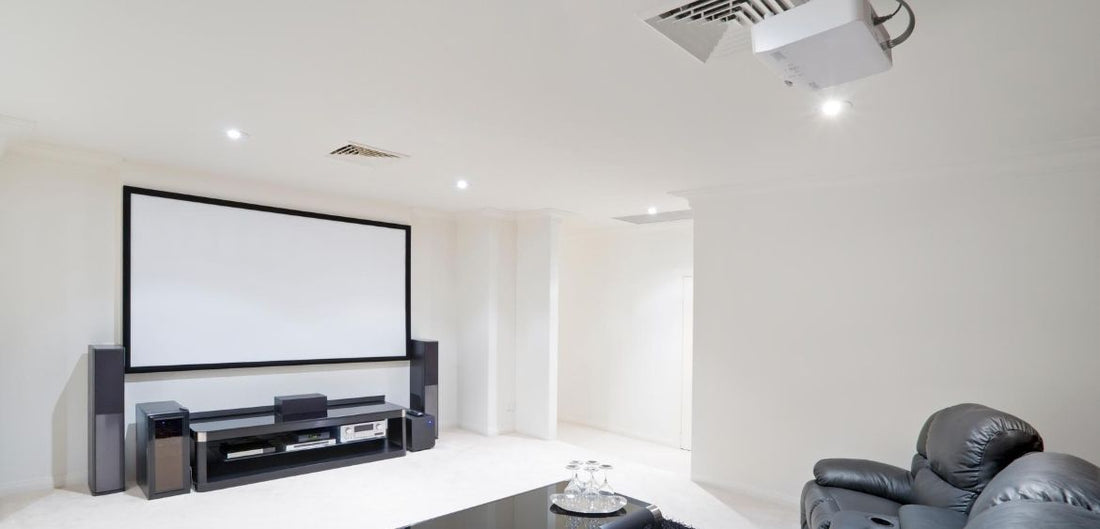A home theater experience is something many seek to have for the comfort and convenience of enjoying their favorite movies at anytime. Projectors and TVs offer different benefits and drawbacks; however, most homes will typically use projectors to replicate the theater experience as close as possible. By using a projector lift, users can further enhance the value of their home theater setup. In this article, we will cover the important aspects of DIY projector lifts to consider such as their pros and cons, setup requirements, and build process.
Comparing Projectors and TVs
To achieve the most authentic home theatre experience, you will require a setup that is as close to perfect as possible. Most individuals may not be able to spend tens of thousands for a home theatre, however, there are also alternative options to help you get the best value in return. This will often be through video projectors which are able to display a large image size for their overall cost. Projectors and TVs come with different benefits and drawbacks to excel in different use cases. If you were wondering whether you should get yourself a projector or a TV, compare the benefits of each option and see which will best suit your priorities.
Projectors vs. TVs
|
Projectors |
TVs |
|
- Displays larger image size - Greater portability - Affordable price point - More authentic atmosphere to a theater experience |
- Higher brightness settings for daytime use - Usually include quality built-in speakers - Lower maintenance - Better image quality from high-end options |
Concealing Your Display Unit
Whether you own a TV or projector, having a motorized lift for display units can enhance the value of your home theater setup. Aside from just adding a surprise element for your guests, the option to conceal your display units help protect it from tampering children, dust, debris, and theft. In some instances, it can also help save space if you were concealing your display unit around areas near cabinets, storage units, or hallway paths. There are also options for different styles of TV lifts to account for a motorized or dropdown TV configuration.
Below is an example of our TY-05-30 dropdown TV lift in action:
Building A DIY Projector Lift

Although pre-built projector lifts are quite a costly investment, the option to create your own DIY projector lift makes the possibility of having a home theater setup more approachable for everyone. If you’ve decided on the projector, you’ll need to know how you are going to mount it.
Deciding the Ceiling Configuration
A motorized projector mount will usually be built to descend from the ceiling. Configuring a drop down projector mount right into the ceiling allows for the projector lift to completely disappear when not in use. The alternative is to have a projector housed in a box attached to your DIY projector ceiling mount. This option will not completely disappear when the projector is not in use, however, it still allows users the ability to adjust height positions.
Choosing Your Actuators
Using electric linear actuators as the drive mechanism for a DIY projector lift will enable for quiet operation. By configuring your actuators to have a full range of travel, your projector lift can take advantage of the actuator’s built-in limit switches to shut off electrical power once it reaches the end of travel. Since the weight of a projector can vary depending on the model, it is important to choose linear actuators with the appropriate force rating. Ensure the force that is being experienced by the actuator's shaft is within the force rating of the unit you selected.
Maintaining Projector Stability

Using a box, you can create any style of it to fit the design of your room, so long as you make it with a removable bottom. The bottom can be attached to a pulley mechanism with sliding guide rails, allowing your projector to ascend as descend while maintaining stability. The alternative solution is to attach the bottom piece to four actuators with the proper configurations to travel the same speed synchronously. We recommend actuators with hall effect sensors if you required two or more actuators to travel synchronously. This would be because they would have hall effect feedback that goes to a control box which would then be able to make the needed corrections to the actuators in case one side travels at a different speed from the other. Differing speeds may be due to slightly unequal weight distribution or the speed tolerance of the DC motors (+/- 10%) in the actuators. The PA-04-HS would be the only actuator we sell with hall effect sensors from off the shelf.
Controlling Your Actuator
The 24VDC versions of the PA-04-HS can be controlled with the FLTCON-4 control boxes and the RT-11 remote for the synchronized motion of multiple actuators. Our FLTCON control boxes require 110 VAC input voltage, and the RT-11 wired remote allows for the control system to display troubleshooting codes. Improving operational convenience through wireless control is also possible using the RT-14 Wireless Remote and RF Receiver. If you were using a single 12 VDC actuator that was attached to a stabilizing pulley mechanism, one single channel control box such as the PA-31 will be a suitable wireless control option. This control box will require 12 VDC for input power which can be accessed through our power supplies such as the PS-13-12 that converts 110 VAC input power to 12 VDC output.
Planetarium Projector Lift Project
Aside from the standard use of watching movies, projectors can also be integrated into other entertainment and educational use cases. One of our talented customers from Free Fall Technologies was nice enough to share his unique Planetarium projector lift project with us. Free Fall Technologies is a planetarium education company that specializes in making interesting educational technology systems for the field. Their project is a custom planetarium projector lift that utilizes the Lifting Column model FLT-03-2-1 to raise itself up and down. Our customer builds these creative planetarium applications using our products to produce reliable and smooth lifting systems. This project required the planetarium to have azimuth rotation capabilities, which basically means that any section of the planetarium will be able to be rotated and positioned in front of the audience. This was achieved by installing a rotation bearing between the lift top and the base of the projector.
In Summary
Projectors are approachable and cost-effective solutions for everyone to display large image sizes while having a compact form factor. By understanding what it takes to make your own motorized projector lift, you too can enhance your home theater experience and enjoy all your favorite movies!
We hope you found this as informative and interesting as we did, especially if you were considering a DIY projector lift for your home setup! If you have any queries or wish to discuss our products further, please do not hesitate in reaching out to us! We are experts in what we do and will be happy to assist in any way we can.
sales@progressiveautomations.com | 1-800-676-6123




